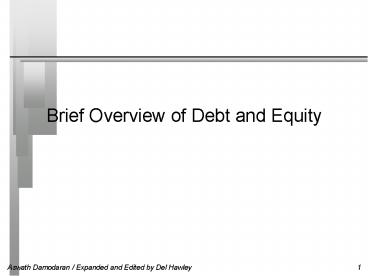Brief Overview of Debt and Equity - PowerPoint PPT Presentation
Title:
Brief Overview of Debt and Equity
Description:
The Only Two Choices for Financing Debt (Leverage) The essence of debt is that you promise to make fixed payments in the future (interest payments and repaying ... – PowerPoint PPT presentation
Number of Views:115
Avg rating:3.0/5.0
Title: Brief Overview of Debt and Equity
1
Brief Overview of Debt and Equity
2
The Only Two Choices for Financing
- Debt (Leverage)
- The essence of debt is that you promise to make
fixed payments in the future (interest payments
and repaying principal). If you fail to make
those payments, you lose control of your
business. - Equity
- With equity, you do get whatever cash flows are
left over after you have made debt payments.
3
Debt versus Equity
Debt Equity
Fixed Claim Residual Claim
High Priority on Cash Flows Lowest Priority on Cash Flows
Interest is Tax Deductible No Tax Break on Dividends
Fixed Maturity Infinite Life
4
When Is It Debt?
- Ask 3 Questions
- Is the cashflow claim created by this financing a
fixed commitment or a residual claim? - Is the commitment tax-deductible?
- If you fail to uphold the commitment, do you lose
control of the business? - If all three answers are Yes, its debt.
Otherwise, its equity or a hybrid.
5
Cost of Debt
- Debt is always the least costly form of
financing. - WHY?
6
Cost of Debt vs. Equity
E(R)
Debt will always be perceived by investors to be
less risky than equity. Therefore, its required
return will always be lower.
Equity
Rf
Debt
ß
7
Debt versus Equity
Factor Debt Equity
Cost Lowest Highest
Risk to the Firm High Bankruptcy and volatility of cashflows Low
Impact on Flexibility High Major restrictions on decision making Low Few restrictions on decision making
Impact on Control Low, unless firm is in bankruptcy Potentially High Many owners
8
The Choices
- Equity can take different forms
- Small business owners investing their savings
- Venture capital for startups
- Common stock for corporations
- Debt can also take different forms
- For private businesses, it is usually bank loans
- For publicly traded firms, it is more likely to
be debentures (bonds) for long-term debt and
commercial paper for short-term debt
9
Compare Advantages and Disadvantages of Debt
- Advantages of Debt
- Interest is tax-subsidized ? Low cost
- Increases upside variability of cashflows to
equity - Adds discipline to management
- Disadvantages of Debt
- Possibility of bankruptcy/financial distress
- Increases downside variability of cashflows to
equity - Agency costs are incurred
- Loss of future flexibility
10
What Does Leverage Mean?
Depending on where the fulcrum is placed, a small
force can be amplified into a much larger force.
11
What Does Leverage Mean?
In financial leverage, the fulcrum is the fixed
cost of the debt financing.
The small force is variability of operating
income.
The large force is the variability of cashflows
to shareholders (EPS)
12
What Does Leverage Mean?
The larger the fixed interest payments
The more a small change in operating profit
Will be amplified into a larger change in EPS
13
What managers consider important in deciding on
how much debt to carry...
- A survey of Chief Financial Officers of large
U.S. companies provided the following ranking
(from most important to least important) for the
factors that they considered important in the
financing decisions - Factor Ranking (0-5)
- 1. Maintain financial flexibility 4.55
- 2. Ensure long-term survival 4.55
- 3. Maintain Predictable Source of Funds 4.05
- 4. Maximize Stock Price 3.99
- 5. Maintain financial independence 3.88
- 6. Maintain high debt rating 3.56
- 7. Maintain comparability with peer group 2.47
14
Why does the Capital Structure Mix matter?
- Value of a Firm Present Value of Cash Flows to
the Firm, discounted back at the cost of capital. - If the cash flows to the firm are held constant
and the cost of capital is minimized, the value
of the firm will be maximized. - So, if capital structure changes do not affect
the cost of capital, then capital structure is
irrelevant since it will not affect firm value.
15
The Most Realistic View of Capital Structure
16
The Most Realistic View of Capital Structure
- The tax advantage of debt would be progressively
offset by the rising potential for bankruptcy and
the resulting financial distress costs, and also
by the rising agency costs. - The result would be that the WACC would fall as
debt went from zero to some larger amount, but
would eventually reach a minimum and then start
to climb. - Thus, there would be an optimal capital
structure where the WACC is minimized. This would
be less that 100 debt.































